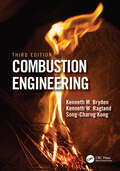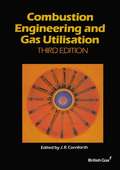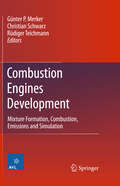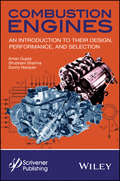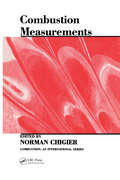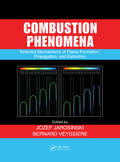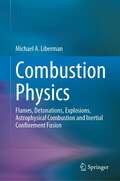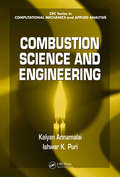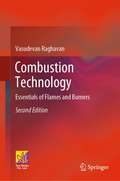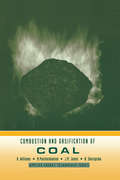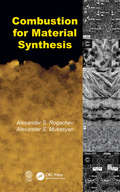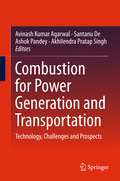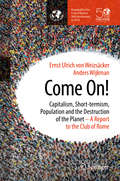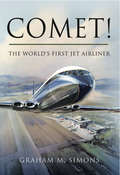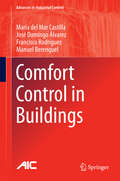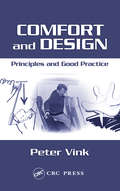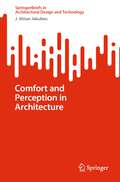- Table View
- List View
Combustion Engineering
by Kenneth W. Ragland Kenneth Bryden Song-Charng KongCombustion Engineering, Third Edition introduces the analysis, design, and building of combustion energy systems. It discusses current global energy, climate, and air pollution challenges and considers the increasing importance of renewable energy sources, such as biomass fuels. Mathematical methods are presented, along with qualitative descriptions of their use, which are supported by numerous tables with practical data and formulae, worked examples, chapter-end problems, and updated references. The new edition features new and updated sections on solid biofuels, spark-ignition, compression-ignition, soot and black carbon formation, and current energy policies. Features include: Builds a strong foundation for design and engineering of combustion systems. Provides fully updated coverage of alternative and renewable fuel topics throughout the text. Features new and updated sections on solid biofuels, spark-ignition, compression-ignition, soot and black carbon formation, and current energy policies. Includes updated data and formulae, worked examples, and additional chapter-end problems. Includes a Solutions Manual and figures slides for adopting instructors. This text is intended for undergraduate and first-year graduate mechanical engineering students taking introductory courses in combustion. Practicing heating engineers, utility engineers, and engineers consulting in energy and environmental areas will find this book a useful reference.
Combustion Engineering and Gas Utilisation
by British GasCombustion Engineering & Gas Utilisation is a practical guide to sound engineering practice for engineers from industry and commerce responsible for the selection, installation, designing and maintenance of efficient and safe gas fired heating equipment.
Combustion Engines Development: Mixture Formation, Combustion, Emissions and Simulation
by Christian Schwarz Günter P. Merker Rüdiger TeichmannCombustion Engines Development nowadays is based on simulation, not only of the transient reaction of vehicles or of the complete driveshaft, but also of the highly unsteady processes in the carburation process and the combustion chamber of an engine. Different physical and chemical approaches are described to show the potentials and limits of the models used for simulation.
Combustion Engines: An Introduction to Their Design, Performance, and Selection
by Aman Gupta Shubham Sharma Sunny NarayanVehicle noise, vibration, and emissions are only a few of the factors that can have a detrimental effects on overall performance of an engine. These aspects are benchmarks for choice of customers while choosing a vehicle or for engineers while choosing an engine for industrial applications. It is important that mechanical and automotive engineers have some knowledge in this area, as a part of their well-rounded training for designing and selecting various types of engines. This volume is a valuable introductory text and a handy reference for any engineer, manager, or technician working in this area. The automotive industry, and other industries that make use of engines in their industrial applications, account for billions, or even trillions, of dollars of revenue worldwide and are important in the daily lives of many, if not most, of the people living on this planet. This is an area that affects a staggering number of people, and the information needed by engineers and technicians concerning the performance of various types of engines is of paramount importance in designing and selecting engines and the processes into which they are introduced.
Combustion Measurements
by Norman ChigierThe book begins with an introduction to the general problems of making measurements in high temperature and a presentation of chemically reacting flow systems. It describes each instrument with the various diagnostic techniques and discusses measurements that have been made in furnaces, flames, and rocket engines. The detailed measurement techniques described in this book cover a wide spectrum of applications in combustion systems, including gas turbine, rocket measurement techniques that were developed in laboratories. Information obtained on detailed temperature, velocity, particle size, and gas concentration distribution is leading to improve understanding of the chemical combustion process and to design imporvements in combustors.
Combustion Optimization Based on Computational Intelligence (Advanced Topics in Science and Technology in China)
by Hao Zhou Kefa CenThis book presents the latest findings on the subject of combustion optimization based on computational intelligence. It covers a broad range of topics, including the modeling of coal combustion characteristics based on artificial neural networks and support vector machines. It also describes the optimization of combustion parameters using genetic algorithms or ant colony algorithms, an online coal optimization system, etc. Accordingly, the book offers a unique guide for researchers in the areas of combustion optimization, NOx emission control, energy and power engineering, and chemical engineering.
Combustion Phenomena: Selected Mechanisms of Flame Formation, Propagation and Extinction
by Jozef Jarosinski Bernard VeyssiereExtensively using experimental and numerical illustrations, CombustionPhenomena: Selected Mechanisms of Flame Formation, Propagation, and Extinction provides a comprehensive survey of the fundamental processes of flame formation, propagation, and extinction.Taking you through the stages of combustion, leading experts visually display, mathematically explain, and clearly theorize on important physical topics of combustion. After a historical introduction to the field, they discuss combustion chemistry, flammability limits, and spark ignition. They also study counterflow twin-flame configuration, flame in a vortex core, the propagation characteristics of edge flames, instabilities, and tulip flames. In addition, the book describes flame extinction in narrow channels, global quenching of premixed flames by turbulence, counterflow premixed flame extinction limits, the interaction of flames with fluids in rotating vessels, and turbulent flames. The final chapter explores diffusion flames as well as combustion in spark- and compression-ignition engines. It also examines the transition from deflagration to detonation, along with the detonation wave structure. With downloadable resources of images that beautifully illustrate a range of combustion phenomena, this book facilitates a practical understanding of the processes occurring in the conception, spread, and extinguishment of a flame. It will help you on your way to finding solutions to real issues encountered in transportation, power generation, industrial processes, chemical engineering, and fire and explosion hazards.
Combustion Physics: Flames, Detonations, Explosions, Astrophysical Combustion and Inertial Confinement Fusion
by Michael A. LibermanThis book provides the latest achievements and original research work in physics of combustion processes and application of the methods developed in combustion physics for astrophysical problems of stars burning, supernovae explosions and a confined thermonuclear fusion. All the materials in the book are presented in a concise and easily accessible way, but at the same time provides a deep physical inside in the phenomena considered. It is an effective theoretical course with the direct practical implications in engineering fields of engine’s development, energy production, safety issues inherent to terrestrial combustion, as well as in thermonuclear combustion in the inertial fusion. This book is aimed at university students, Ph.D. students and engineers, as well as professionals in combustion, energy-related research, astrophysics and researchers in neighboring fields.
Combustion Science and Engineering (Applied and Computational Mechanics)
by Kalyan Annamalai Ishwar K. PuriWhile the basic concepts in any discipline may not vary, the problems it faces do change. Combustion Science and Engineering is for students and engineers who wish to understand combustion fundamentals and apply them to engineering problems. In several instances, the authors have included physical explanations along with the mathematical relations and equations so that the principles can be applied to solve real world combustion and pollution problems. The book contains an outline of the corpuscular aspects of thermodynamics and introduces the background related to combustion of solid, liquid, and gaseous fuels. Exercise problems, formulae, and tables appear at the end of text. Students embarking on their studies in chemical, mechanical, aerospace, energy, and environmental engineering will face continually changing combustion problems, such as pollution control and energy efficiency, throughout their careers.
Combustion Technologies for a Clean Environment
by Maria G. da Graca Carvalho Woodrow A. Fiveland F. C. Lockwood Christos PapadopoulosSelected Papers from the Proceedings of the First International Conference Vilamoura, Portugal, September 3-6, 1991. The 54 papers in this volume establish the first in a series of biannual benchmarks for technologies that maximize energy conversion while minimizing undesirable emissions. Covering the entire range of industrial and transport combustion as well as strategies for energy R&D, these contributions will be useful to mechanical and chemical engineers in academia and industry, and technical personnel in military, energy and environmental agencies of government. Among topics covered in the book are: strategies: now and in the future; pulverised coal combustion; oil combustion; gas combustion; gas fired systems, biomass combustion; fluidized bed combustion; incinerators; internal combustion; engines and reaction kinetics.
Combustion Technology for a Clean Environment: Selected Papers for the Proceedings of the Third International Conference, Lisbon, Portugal, July 3-6, 1995 (Energy, Combustion and the Environment)
by Maria CarvalhoThe more than 90 refereed papers in this volume continue a series of biannual benchmarks for technologies that maximize energy conversion while minimizing undesirable emissions. Covering the entire range of industrial and transport combustion as well as strategies for energy research and development, these state-of-the-art will be indispensable to mechanical and chemical engineers in academia and industry and technical personnel in military, energy and environmental government agencies.
Combustion Technology: Essentials of Flames and Burners
by Vasudevan RaghavanThis textbook is intended for post-graduate students in mechanical and allied engineering disciplines. It will also be helpful to scientists and engineers working in the areas of combustion to recapitulate the fundamental and generally applied aspects of combustion. This textbook comprehensively covers the fundamental aspects of combustion. It includes physical descriptions of premixed and non-premixed flames. It provides a detailed analysis of the basic ideas and design characteristics of burners for gaseous, liquid and solid fuels. A chapter on alternative renewable fuels has also been included to bring out the need, characteristics and usage of alternative fuels. Review questions have been provided at the end of each chapter which will help the students to evaluate their understanding of the important concepts covered in that chapter. Several standard text books have been cited in the chapters and are listed towards the end, as suggested reading, to enable the readers to refer them when required. The textbook will be useful for students in mechanical, aerospace and related fields of engineering. It will also be a good resource for professionals and researchers working in the areas of combustion technology.
Combustion and Gasification of Coal (Applied Energy Technology Ser.)
by A. WilliamsIncuding an overview of two of the most common uses of coal: combustion and gasification. First, it outlines problems and possible solutions, and then the nature of coal is described. The book goes on to describe the technical aspects of combustion of pulverized coal and the combustion mechanism of coal in fixed, moving, and fluidized beds. Industrial coal combustion applications are then outlined, together with other combustion applications, including co-firing, coal-water, slurries, and briquettes. Finally, gasification of coal, a possible major clean coal technology of the future, is discussed.
Combustion for Material Synthesis
by Alexander S. Rogachev Alexander S. MukasyanThis book summarizes the state of the art in combustion synthesis of advanced materials. It is a first attempt to summarize and critically review in one monograph the mechanisms of combustion and product structure formation for a variety of systems, including nanosystems. The authors discuss a wide range of topics including phenomenology, theory, and modern in-situ experimental approaches to investigate the heterogeneous self-sustained reactions, as well as properties of the product synthesized, and methods for large-scale materials production.
Combustion for Power Generation and Transportation: Technology, Challenges and Prospects
by Ashok Pandey Avinash Kumar Agarwal Santanu De Akhilendra Pratap SinghThis research monograph presents both fundamental science and applied innovations on several key and emerging technologies involving fossil and alternate fuel utilization in power and transport sectors from renowned experts in the field. Some of the topics covered include: autoignition in laminar and turbulent nonpremixed flames; Langevin simulation of turbulent combustion; lean blowout (LBO) prediction through symbolic time series analysis; lasers and optical diagnostics for next generation IC engine development; exergy destruction study on small DI diesel engi≠ and gasoline direct injection. The book includes a chapter on carbon sequestration and optimization of enhanced oil and gas recovery. The contents of this book will be useful to researchers and professionals working on all aspects on combustion.
Come On!: Capitalism, Short-termism, Population and the Destruction of the Planet
by Anders Wijkman Ernst Ulrich von WeizsäckerCurrent worldwide trends are not sustainable. The Club of Rome’s warnings published in the book Limits to Growth are still valid. Remedies that are acceptable for the great majority tend to make things worse. We seem to be in a philosophical crisis. Pope Francis says it clearly: our common home is in deadly danger. Analyzing the philosophical crisis, the book comes to the conclusion that the world may need a “new enlightenment”; one that is not based solely on doctrine, but instead addresses a balance between humans and nature, as well as a balance between markets and the state, and the short versus long term. To do this we need to leave behind working in ”silos” in favor of a more systemic approach that will require us to rethink the organization of science and education.However, we have to act now; the world cannot wait until 7.6 billion people have struggled to reach a new enlightenment. This book is full of optimistic case studies and policy proposals that will lead us back to a trajectory of sustainability. But it is also necessary to address the taboo topic of population increase. Countries with a stable population fare immensely better than those with continued increase. Finally, we are presenting an optimistic book from the Club of Rome.
Come and Take It: The Gun Printer's Guide to Thinking Free
by Cody WilsonCody Wilson, a self-described crypto-anarchist and rogue thinker, combines the controversial yet thrilling story of the production of the first ever 3D printable gun with a startling philosophical manifesto that gets to the heart of the twenty-first century debate over the freedom of information and ideas.Reminiscent of the classic Steal This Book by Abbie Hoffman, Cody Wilson has written a unique, critical, and philosophical guide through the digital revolution. Deflecting interference from the State Department and the Bureau of Alcohol, Tobacco, Firearms and Explosives, the story of Defense Distributed--where Wilson's employees work against all odds to defend liberty and the right to access arms through the production of 3D printed firearms--takes us across continents, into dusty warehouses and high rise condominiums, through television studios, to the Texas desert, and beyond. Harkening to both Zen and the Art of Motorcycle Maintenance and The Anarchist Cookbook, Come and Take It follows a group of digital radicals as they navigate political subterfuge to create a technological miracle, against all odds. Combining elements of a modern-day thriller with a fascinating philosophical treatise, Wilson paints a scathing and timely portrait of an ideologically polarized America and his own struggle in the fight for liberty.
Come gestire Litecoin
by Adidas WilsonLitecoin è stato fondato per fungere da alternativa al Bitcoin, rimediando così alle limitazioni riscontrate da quest'ultimo - è stato sviluppato per essere "leggero" e più efficiente del Bitcoin. Inoltre ha un costo di pagamento quasi nullo e facilita i pagamenti circa quattro volte più velocemente del Bitcoin. Gli argomenti trattati includono: guida ai portafogli di criptovalute; come comprare Litecoin; minare Litecoin e altre altcoins; l'investimento migliore: Bitcoin o Litecoin; servizi di portafogli Litecoin; Bitcoin vs. Litecoin; e molto altro ancora.
Come guadagnare con la stampa 3D: la nuova rivoluzione digitale
by Adidas WilsonPoiché la stampa 3D sta diventando popolare, molte persone stanno guadagnando una fortuna e stanno diventando grandi nel settore. Tale risultato potrebbe non essere un gioco da ragazzi, ma cercare modi per ottenere una svolta è di gran lunga l'unico modo per arrivarci e realizzare ciò che altri hanno concettualizzato in mezzi per fare soldi. Se hai sempre avuto interesse per la stampa 3D e vuoi guadagnare con questa tecnologia, è giunto il momento di lavorare in modo intelligente per vincere le sfide future. I modelli 3D stampabili possono essere creati con un pacchetto CAD (Computer Aided Design), tramite uno scanner 3D o con una semplice fotocamera digitale e un software di fotogrammetria. I modelli stampati in 3D creati con CAD determinano una riduzione degli errori e possono essere corretti prima della stampa, consentendo la verifica nel design dell'oggetto prima che venga stampato. Diversi progetti e aziende stanno compiendo sforzi per sviluppare stampanti 3D convenienti per l'uso desktop da casa. Gran parte di questo lavoro è stato guidato e mirato a comunità fai-da-te / creatori / appassionati / early adopter, con legami aggiuntivi con le comunità accademiche e hacker. La stampa tridimensionale rende tanto economico creare singoli articoli quanto produrne migliaia e quindi mina le economie di scala. Potrebbe avere un impatto profondo sul mondo come l'avvento della fabbrica... Proprio come nessuno avrebbe potuto prevedere l'impatto della macchina a vapore nel 1750 - o della macchina da stampa nel 1450, o del transistor nel 1950 - esso è impossibile prevedere l'impatto a lungo termine della stampa 3D. Ma la tecnologia sta arrivando ed è probabile che sconvolgerà ogni campo che tocca.
Come pubblicare un eBook senza impazzire. E che qualcuno lo legga
by Riccardo Cassetta Alejandro AguayoManuale con trucchi e dritte per pubblicare un eBook e promuoverlo. Con le dritte esclusive degli autori dei libri più venduti su Amazon come Enrique Laso, Blanca Miosi, Bruno Nievas, Roberto López-Herrero, Gabri Ródenas e altri
Comet!: The World's First Jet Airliner
by Graham M. Simons&“A masterpiece of the most diligent research and extraordinary detail and surely represents the definitive study of the Comet . . . a terrific book.&”—Royal Aeronautical Society This volume from the respected and well-regarded aviation historian and author Graham Simons is &“a solid book of such scope that you&’ll probably consult it for a lot more than just Comet material&” (SpeedReaders.info). Extensively illustrated throughout, Comet! features details lifted directly from enquiry and salvage reports, much of which have never been published before and offers a unique insight into the failures and tragedies that blighted the early days of development, laying down lessons that were ultimately to benefit later designs. As part of his research into the book, the author met and interviewed Harry Povey, the De Havilland Production Manager and John Cunningham, the Comet test pilot who would be the first to experience flight at the helms of the iconic craft. Both of these first-hand accounts are relayed in the book, adding a deeper sense of authenticity and a more personalized account of proceedings than facts and reports alone are able to achieve. Attention is also paid to the derivative Nimrod design, and the book features an interview that the author conducted with the aircraft commander of the last ever Nimrod operational flight. Interviews of this kind are supplemented by the author&’s own narrative of proceedings, setting personal experience within historical context and exploring the themes and historical topics that the interviews evoke. &“An outstanding account of the life of the Comet . . . all readers will find inspiration and achievement in the tale.&”—Firetrench
Comfort Control in Buildings (Advances in Industrial Control)
by Manuel Berenguel Francisco Rodríguez María del Mar Castilla José Domingo ÁlvarezThe aim of this book is to research comfort control inside buildings, and how this can be achieved through low energy consumption. It presents a comprehensive exploration of the design, development and implementation of several advanced control systems that maintain users' comfort (thermal and indoor air quality) whilst minimizing energy consumption. The book includes a detailed account of the latest cutting edge developments in this area, and presents several control systems based on Model Predictive Control approaches. Real-life examples are provided, and the book is supplemented by illustrations, tables, all of which facilitate understanding of the text. Energy consumption in buildings (residential and non-residential) represents almost the half of the total world energy consumption, and they are also responsible for approximately 35% of CO2 emissions. For these reasons, the reduction of energy consumption associated with the construction and use of buildings, and the increase of energy efficiency in their climatic refurbishment are frequently studied topics in academia and industry. As the productivity of users is directly related to their comfort, a middle ground needs to be found between comfort of users and energy efficiency. In order to achieve this, it is necessary to develop innovation and technology which can provide comfortable environments with minimum energy consumption. This book is intended for researchers interested in control engineering, energy and bioclimatic buildings, and for architects and process control engineers. It is also accessible to postgraduate students embarking on a career in this area, particularly those studying architecture.
Comfort and Design: Principles and Good Practice
by Peter VinkLinking comfort and design, this book is the first reference to explore the comfort/discomfort paradigm. Comfort and Design: Principles and Good Practice presents cases that demonstrate the success that companies from five countries around the world have enjoyed by engineering products with comfort in mind. The contributors discuss the theory behind comfort design and demonstrate practice by using case examples, presenting these elements together for the first time in one source. The text also explores the costs and benefits associated with reducing discomfort and increasing comfort. This book will serve as a guide to developing and implementing effective design strategies to deal with comfort.
Comfort and Perception in Architecture (SpringerBriefs in Architectural Design and Technology)
by J. Alstan JakubiecThis book discusses the design of comfortable buildings and shows that design perception and, as a result, comfort should be an intentional feature of architectural design. Modern buildings are often sealed boxes without operable windows or daylighting design. However, contemporary designers increasingly find themselves faced with the task of creating spaces that are comfortable in terms of thermal and visual aspects.
Comfortably Unaware: What We Choose To Eat Is Killing Us And Our Planet
by Richard OppenlanderIn Comfortably Unaware, Dr. Richard Oppenlander tackles the crucial issue of global depletion as it relates to food choice. We should all be committed, he tells us, to understanding the reality and consequences of our diet, the footprint it makes on our environment, and seek food products that are in the best interest of all living things. His forthright information and stark mental images are often disturbing-and that's how it should be. As the guardians of Planet Earth, we need to be shaken out of our complacency, to stop being comfortably unaware, and to understand the measures we must take to ensure the health and well-being of our planet-and of ourselves. Oppenlander
